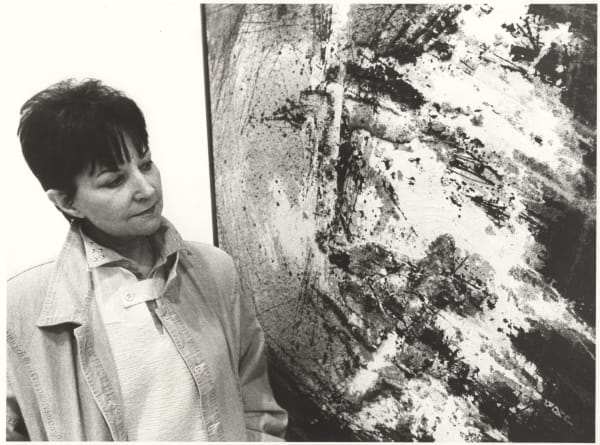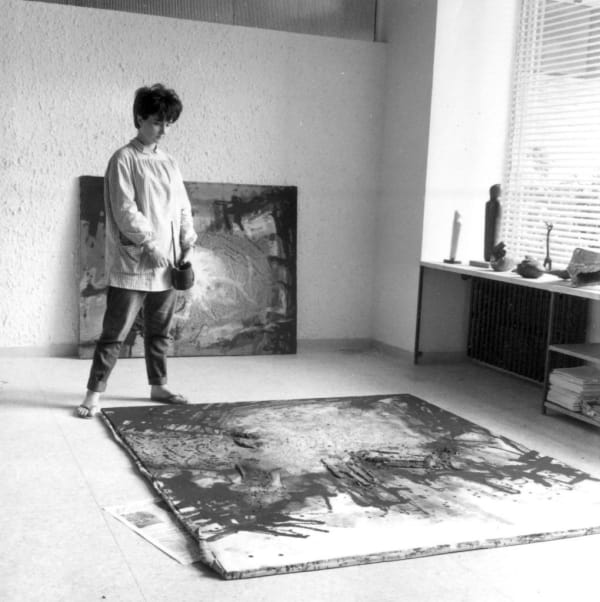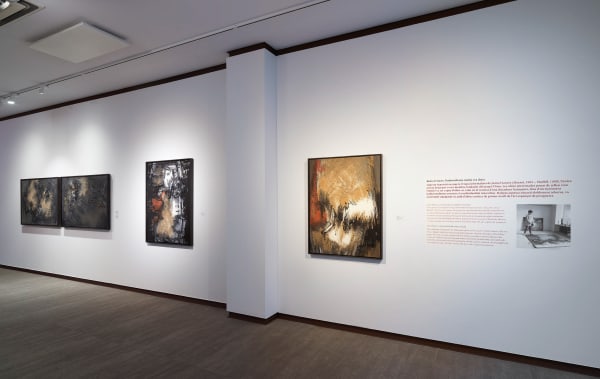Juana Francés: Informalism Was Also Female: BARCELONA
Being a woman artist has been — and still is — an additional difficulty in the recognition of artistic talent, but this difficulty was much more accentuated in the patriarchal and repressive society of the Franco dictatorship. It was in such a context that towards the mid-1950s Juana Francés got into abstract, gestural and materic painting. This turn, as the curator observes in his essay for the catalogue of the show, coincided in time with the one also effected by other painters of the day and, in a similar way to them, was largely due to the awareness Spanish artists were henceforth to have of the new artistic currents developing in the international arena: European Informalism and American Abstract Expressionism.
The artist consolidated her Informalist phase between 1957 and 1962. In the works from this period she combined sand and pigment with other materials to obtain dense textures that lend the picture a certain three-dimensionality. This subtle volume is further emphasized by the luminosity arising from the superimposition of patches of colour in an austere palette and through the golden tones of the earth that can be readily observed in the MACA’s two Untitled paintings from 1959. The compositions are open-ended and dynamic, with energetic, impulsive brushstrokes midway between the graphism of Franz Kline and the Tachism of Hans Hartung, two of her chief sources of inspiration. We can see this in the grattage in black of Como tierra, nº 51 (Like Earth, No. 51) (1959-1960) or the broad brushstrokes of the same colour predominating in Algaiat (1960). Francés herself explained that in order to create these highly expressive artworks, “I regularly used broad brushes; the impressions I did with big palette knives. I also used gestural watering, mainly to move sand and grit; this consisted in flinging water, with or without colour, on top of the textures. On occasion I strewed sand and grit on the base of acrylic glue, which I later 1. modified with the brush, producing rhythms with the brushstrokes.”[1]
The materic Informalism of Juana Francés, observes Tomàs Llorens, presented “a purity and a radicalness that was consistently remarked upon by the critics of the day. As it was, the rejection of all iconic reference and the concentration on the most extreme tactility converted the pictures […] we are presenting in this exhibition into radically ineffable presences. Presences that go on speaking to us today even though more than half a century has elapsed since their creation.” The fact of the matter is that as well as being one of the original members of the El Paso group and signing its founding manifesto in 1957 — despite taking her leave of it that same year — Francés was assured of recognition at the national level and abroad. In the international arena it is worth recalling her participation in different editions of the Venice Biennale (1954, 1960 and 1964), in the exhibition Before Picasso; After Miró at the Solomon R. Guggenheim Museum in New York in 1960, and in Modern Spanish Painting held at the Tate Gallery in London in 1962.
Thus, as Carles Guerra and Agustín Pérez Rubio conclude in the discussion they conducted on the occasion of this exhibition, included in the catalogue, we are in the presence of a creative person who was adept at appropriating a practice traditionally associated with masculinity, thereby vindicating herself as an artist and situating herself at the same level as the male counterparts of her generation, among whom were to be found Manolo Millares, Antonio Saura, Antoni Tàpies and Eduardo Chillida, whose works have also been seen at Mayoral in exhibitions held in recent years.
Exhibition curated by Tomàs Llorens Serra.
[1] FRANCÉS, Juana. n.d. In: Juana Francés. Una voluntad investigadora [exh. cat.]. Zaragoza: Gobierno de Aragón, 2019, p. 4.

-
![Art Talk: Conversations with 12 Women Artists [excerpts] by Cindy Nemser](https://artlogic-res.cloudinary.com/w_600,c_limit,f_auto,fl_lossy,q_auto/ws-artlogicwebsite1593/usr/images/news/main_image/42/05nemser1-mediumsquareat3x.jpg)
Art Talk: Conversations with 12 Women Artists [excerpts] by Cindy Nemser
Cindy Nemser interviews Barbara Hepworth and Lee Krasner June 26, 2020Barbara Hepworth United Kingdom, 1903-1975 Barbara Hepworth (BH): Well you need to know what to do and discipline yourself. I mean my home came first...Read more -

Interviews with Juana Francés
Juana Francés' interviews by Luis Blánquez Benito April 7, 2020juana Francés at the Ateneo [1] Luis Blánquez Benito (LBB): In our Studios we have the painter Juana Francés, who is currently holding an exhibition...Read more -

A Conversation between Boye Llorens and Isabel Tejeda
On the occasion of the exhibition "Juana Francés: Informalism Was Also Female" at Galeria Mayoral, Barcelona March 27, 2020Boye Llorens (BL): The Juana Francés exhibition at the Mayoral gallery focuses on the years between 1957 and 1962, an Informalist phase closely linked to...Read more -

A Conversation between Carles Guerra and Agustín Pérez Rubio
On the occasion of the exhibition "Juana Francés: Informalism Was Also Female" at Galeria Mayoral, Barcelona February 12, 2020Agustín Pérez Rubio (APR): The Francés case is the typical case of an artist who is totally undervalued in her context. Even though she’s had...Read more -

Juana Francés: 1957-1962 | Tomàs Llorens
Tomàs Llorens talks about his curated exhibition "Juana Francés: Informalism Was Also Female" at Galeria Mayoral, Barcelona January 24, 2020The period from 1957 to 1962 encapsulates one of the most brilliant episodes in the history of Spanish modern art. A group of painters and...Read more










